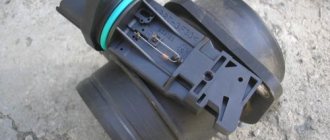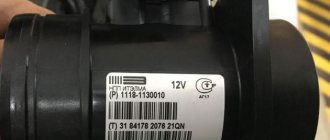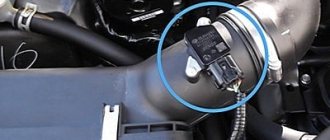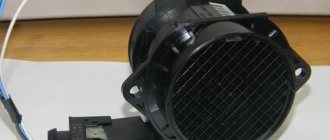Simultaneously with the advent of front-wheel drive on VAZ cars, power plants were also updated. At least the engine management systems (ECU) have been revised. In this regard, mass air flow sensors (mass air flow sensors) on VAZ 2109 vehicles are available in three versions, produced by the German concern BOSCH:
- With the last digits in the index 004, designed for Bosch M 1.5.4 ECU. The performance of this sensor greatly affects the performance of the motor, so if it fails, urgent replacement is necessary.
- With the last digits in the index 037: compatible with ECU BOSCH M 1.5.4 N, as well as / January series 5.1, 5.1.1, 5.1.2. A fairly reliable air flow sensor, however, it has factory shortcomings. It does not work with engines converted to LPG and is extremely sensitive to blockages. The last point concerns tuning enthusiasts: installing sports air filters is unacceptable.
- With the latest digits in the index 116: designed for new versions of engines with BOSCH ECU M 7.9.7 and January 7.2. It can work with gas equipment, but still does not tolerate clogging.
Help: calling these devices mass air flow sensors is a little incorrect, since the measurements relate to the volume of the air mass and the oxygen content in it. However, the abbreviation DFID has already become entrenched in the minds of car enthusiasts, and is therefore used by all manufacturers.
Purpose of the mass air flow sensor
The mass air flow sensor, or flow meter, is an important component of the injection engine of the VAZ 21093 i. It is responsible for the formation of the air-fuel mixture in the required proportions, for the supply of the proper volume of air oxygen to the combustion chambers. Depending on the MAF readings, the electronic engine control unit (ECU) determines the amount of gasoline injected into the cylinder and the specific moment at which the igniting spark is supplied.
The ECU takes into account not only the readings of the air flow sensor. It also uses other meters available in the car: throttle opening angle, temperature of the fluid circulating in the engine, detonation (designed to correct the advance angle in the event of detonation), oxygen (provides feedback on monitoring the quality of combustion of the mixture in the combustion chambers), crankshaft position , vehicle speed and, finally, a phase sensor (monitors the valve timing of a sixteen-valve engine).
Sensor readings are transmitted to the controller. Regulation based on these data ensures maximum engine power, minimum fuel consumption and the standard content of carbon monoxide in the exhaust gases.
The mass air flow sensor on VAZ 2109 cars is installed in the air filter housing in the outlet line, in front of the air supply pipe to the engine.
Reasons for failure
The main causes of failure of a frequency or electronic flow meter:
- The mesh located inside the device is clogged. Crankcase gases or propane pass through the regulator along with the air flow when it is connected to the throttle assembly module. This leads to the formation of deposits on the sensor threads, which disrupts normal operation and increases fuel consumption.
- Failure of threads as a result of natural wear or improper use. The mass flow sensor has a limited service life, which on average is about 100-150 thousand kilometers. Failure of the regulator is also possible as a result of detonation of the controller in the throttle assembly.
- Power unit overload. As a result of overheating of the flow meter and its individual components, incorrect data may be sent to the motor control unit. When the metal is seriously heated, the level of its electrical resistance changes, which leads to a change in the calculated data for the volume of air passing through.
- Mechanical damage to the sensor, which could occur when replacing the air filter or other mechanisms and components located in proximity to the regulator. It is possible that the contact elements located on the connection block may be damaged during installation.
- Large volumes of water entering the engine compartment. This leads to a short circuit on the power supply and control lines of the flow meter.
Mass air flow sensor design
The most common automotive mass air flow sensors operate on the principle of the so-called “heated string”. The string is made of metal and can look different: for a GM device it is a wire with a diameter of about 70 microns, for a BOSH sensor it is a special mesh membrane. The string is placed in the flow of air entering the engine, which cools the metal.
An electric current is passed through the string, which in turn heats the string. Another similar string is placed outside the air flow and used as a temperature standard. The resistor bridge automatically supplies such electric current to the string in the air flow so that it remains heated to the reference temperature. The stronger the air flow, the greater the cooling of the string and the more electricity is required to maintain a stable temperature.
The string is made of platinum: the resistance of this metal strongly depends on temperature. This ensures high sensitivity of the device and accuracy in determining air flow speed. By measuring the voltage on the “heated string”, the device determines the speed of the incoming air. It is the speed of the flow, multiplied by the cross-sectional area of the channel, that determines the volume of air entering the engine per unit time.
In physics, there are two types of mass: gravitational (as in the law of universal gravitation) and inertial (as in Newton’s second law, connecting mass, force and acceleration). The injector sensor on the VAZ 2109 does not measure either gravitational or inertial mass at all. It determines not the mass, but the volumetric air flow. This is correct from the point of view of the theory of operation of the internal combustion engine, which is described in thermodynamic concepts. We are always talking about pressure, temperature, working volume of a gas, but not about its mass.
The electronic control unit linearizes the mass air flow sensor measurements and issues control commands to the injector taking into account the air temperature, its humidity and the current operating mode.
Methods for checking sensor functionality
How to check the flow meter yourself? There are several diagnostic options, we suggest you familiarize yourself with each of them (the author of the video is the Bezdelnik TV channel).
Shutdown
First you need to try disconnecting the flow meter from the power supply. To do this, you need to start the engine and let it run for a while. Next, you will need to disconnect the plug from the flow meter - after this, the emergency mode of operation of the motor should be activated. In this case, the volume of required air flow will be calculated in accordance with the throttle position. If, after switching off, you notice that the engine began to work more correctly and at the same time it became more dynamic, then the mass air flow sensor definitely needs to be replaced.
Diagnostics using a multimeter
Diagnostics can be performed using a multimeter; for this we recommend that you read the operating instructions for the tester. The device must be configured in the DC voltage measurement mode; it is usually marked with the symbols DCV or V.
To ensure that connecting the device does not cause difficulties, you need to know exactly the pinout of the device:
- black-red or pink contact is a connection to the control module;
- green is ground (grounding, ground), connected to the body or battery;
- gray-white contact - output voltage;
- yellow - used to supply current to the input.
Diagnostics with a multimeter is performed as follows:
- To begin with, the tester should be turned on and the voltage value set on it to 20 volts, and then the probes from the device are connected to the corresponding contacts on the plug.
- To make the connection more convenient, you can use pins; you will need two of them. Each of them is installed in a hole with green and yellow contacts. Then you will need to connect the probes of the device to these pins.
- The next step is to activate the ignition and measure the voltage. Read more about the test results below (the author of the video is the IZO channel)))LENTA).
On a working device, the voltage level will be around 1.01-1.04. If the readings are between 1.02 and 1.05 volts, this indicates that the device will need to be changed in the near future. If the readings obtained are higher, then the flow meter must be replaced because it is faulty.
It should be noted that during operation, the voltage parameter will only increase, since the resistor components of the device wear out, and the resistance value, accordingly, decreases. You can also accurately determine the voltage using the on-board computer, if it has the appropriate function. To search, go to the flowmeter voltage section and find the U value.
Visual inspection
As for visual diagnostics, first of all it is necessary to check the condition of the corrugation in which the flow meter is installed, as well as the device itself. If, as a result of the check, you see traces of motor fluid or condensation, then it is possible that the device does not work for this reason. In some cases, cleaning the device from contaminants allows the flowmeter to resume operation and prevent possible replacement. It should be taken into account that contaminants usually accumulate as a result of infrequent replacement of the air filter element (the author of the video about the regulator malfunction is the channel In Sandro’s Garage).
If you notice traces of engine fluid, then there is a possibility that the reason lies in a clogged oil seal, or the problem may lie in exceeding the permissible level of lubricant in the crankcase. When cleaning is complete, you will need to make a visual inspection of the regulator - on the front of it you can see the rubber seal that is used for sealing. The seal is necessary to prevent uncleaned air flow and it may be that the rubber band moves a little - this will lead to the accumulation of dust on the flowmeter grid.
Diagnosis of device malfunctions
Determining a problem with the mass air flow sensor is not so easy. Many symptoms of failure of this sensor coincide with signs of failure of other components and assemblies of the car. Typical symptoms of problems with the mass air flow sensor are cases when:
- the engine noticeably loses power;
- there are failures when pressing the accelerator;
- fuel consumption increases significantly;
- Starting a warm engine becomes more difficult.
When the mass air flow sensor fails, the Check Engine light on the dashboard lights up. But it turns on not only when the mass air flow sensor fails. And it’s not at all easy to figure out what kind of breakdown the indicator is signaling in this case, so it’s better to turn to professionals for diagnostics.
Cases when the average car enthusiast can figure it out on his own are relatively rare. These include a situation when you suspect a failure of the mass air flow sensor, and your friend has the same “nine” as yours with a perfectly working engine. Borrow a known-good air flow sensor from a friend for one hour. Remove your sensor, install a good one, and go for a ride. If the problems disappear, go to the store for a flow meter: the problem is that the mass air flow sensor is broken.
For some BOSH sensors, craftsmen offer a method of instrumental performance monitoring. The approach is applicable to flow meters with catalog indexes 0-280-218-004, 0-280-218-037, 0-280-218-116. A portable DC voltmeter up to 2 Volts is used for testing. Measure the voltage between the first (yellow wire) and third (green wire) pins of the mass flow sensor. Take measurements with the ignition on, but do not start the engine. A voltage of 1.02 V or less indicates that the sensor is working, and a voltage of 1.05 V or more indicates that it is broken.
Pay attention to the accuracy class of the device; differences of 1–2 units in the rightmost digit often lie within the error range.
Main symptoms
So. If you have problems with your mass air flow sensor, the signs of a malfunction can be very different. Among them are failures during acceleration, lack of traction, and decreased power. There is a persistent feeling that the car simply “does not go.” If there is no proper response when you press the gas, then this is one of the signs. High fuel consumption is also a signal for diagnosing this sensor. When your car stalls when shifting from gear to gear, it makes sense to check the MAF sensor. The VAZ 2110 has the same symptoms of malfunction as other cars.
When should you clean the sensor?
The condition and degree of wear of the air filter on which the first one is installed is of great importance for the long and proper operation of the sensor. So, if the filter is in good working order and does a good job of filtering dust particles and small abrasive particles in the air, then the sensor will last a long time. If the filter wears out, the sensor quickly becomes dirty and stops working correctly.
You can find out that the VAZ 2114 DMRV needs to be cleaned by one of the following signs:
- the car is poorly controlled when accelerating, there are sharp drops in speed, acceleration and jerking;
- engine speed at idle is extremely high or, on the contrary, intermittent;
- fuel consumption has increased sharply (in the case of the 14th model it can increase even by 50%);
- the engine stopped starting.
Cleaning the air flow sensor using mechanical force or a jet of compressed air is strictly prohibited - such a procedure will instantly lead to its breakdown.
In most of these cases, it is not necessary to immediately run for a new sensor - simply cleaning it will help.
Checking and repairing at home
There are eight ways to independently check amplitude and frequency mass flow sensors.
Method No. 1 - disabling the air flow meter
The method consists of disconnecting the sensor from the fuel system of the car and checking the functionality of the system without it. To do this, you need to disconnect the device from the connector and start the engine. Without a mass air flow sensor, the controller receives a signal to switch to emergency operation mode. It prepares the air-fuel mixture only based on the throttle position. If the car moves faster and does not stall, it means that the device is faulty and requires repair or replacement.
Troubleshooting methods
If the diagnostics show that the mass air flow sensor is not working, then many car owners decide to immediately install a new sensor. In some cases, cleaning the regulator makes it possible to revive it.
How to clean the VAZ air flow sensor:
- First, using a Phillips-head screwdriver, you need to loosen the clamp securing the air intake pipe. Remove the corrugation and make sure that there are no traces of engine fluid or condensation inside. Also perform a visual inspection of the regulator surface.
- As practice shows, the cause of the problem is often the sensitive element, which usually breaks due to the accumulation of dirt inside the device. To prevent dust from accumulating, it is necessary to change the air filter from time to time.
- The controller itself is mounted on the corrugation using two bolts; they can be unscrewed using an open-end wrench. If you need to remove and replace the regulator, you can do so at this stage.
- From the front you can see the entrance on which the sealing rubber is mounted. Its purpose is to protect the system from the suction of dirty air flow coming from outside and not passing through the filter. If there is no sealing rubber, then most likely it could get caught through the filter element. Ultimately, the device's inlet mesh may become dirty. To restore functionality, you can try to clean it; for this, improvised means are used. For example, in practice, the mesh can be effectively cleaned with a toothbrush or toothpick. Alternatively, you can use WD-40 or a special cleaner for cleaning.
- After cleaning is completed, a rubber seal must be installed in place. When all work is completed, the regulator is put in place, all components are assembled in the reverse order.
Cleaning DMRV VAZ 2114
Since purchasing a new mass air flow sensor is far from a cheap pleasure, you should first try to restore it by cleaning it. If it doesn't help, you'll just have to buy a new device. True, before you start repairing the VAZ 2114 DMRV with your own hands, you should firmly understand that the sensor is a very sensitive and fragile device. That is why when cleaning it (and any other manipulations with it), maximum care should be taken.
For the same reason, it is PROHIBITED to use the following substances and compositions to clean it:
- containing acetone;
- synthetic solvents;
- petrol;
- liquids intended for flushing carburetors based on ketones/acetone;
- esters, as well as compositions based on them.
In addition, it is strictly forbidden to clean the air flow sensor using mechanical means - cotton swabs, rags, or blowing with compressed air. Any of these methods will lead to immediate failure of the device without the possibility of further repair.
The best option for cleaning the air sensor is to briefly apply WD-40 to it, followed by rinsing with a solution of ethyl alcohol.











